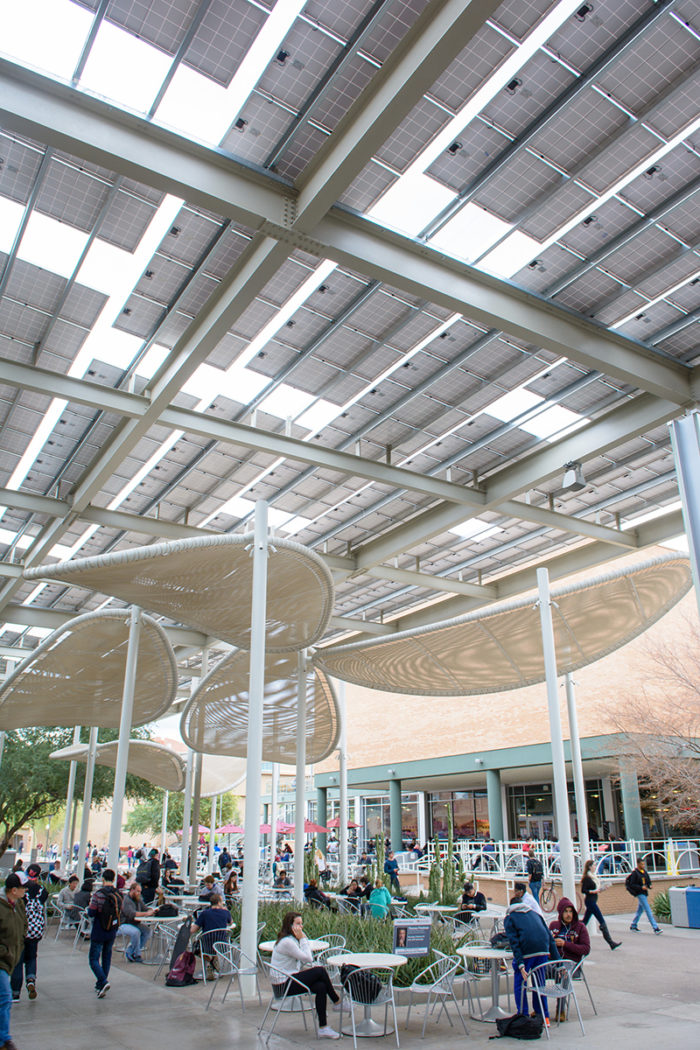
Image Credit: Robin Kiyutelluk / ASU
By BEN GOLDFARB
The soul of Arizona State University is Memorial Union, a hulking brick-and-glass community center that opens onto a sprawling pedestrian mall. Although the building sits at the heart of campus, its outdoor plaza was once virtually uninhabitable for four months each year, when summer temperatures in scorching Tempe often hover over 100 degrees.
So in 2014, the university — Arizona’s leading energy consumer — completed construction on a PowerParasol, a 25-foot-tall shade canopy composed of 1,380 photovoltaic panels capable of producing 397 kilowatts of electricity.
“These solar systems have transformed the area,” says Gerry Darosa, director of energy innovations at Arizona State. “You’ll see people singing, talking, eating — it’s become a vibrant social gathering place.”
The Memorial Union’s PowerParasol is just one installation within Arizona State’s expansive network of 88 solar systems, which now produces 41,000 megawatt hours annually — enough to power nearly 4,000 average U.S. homes. Arizona State’s solar capacity stands second among American universities, behind only rival University of Arizona, and it’s about to grow further: The state’s largest electric utility is building an off-site facility that will provide the campus with another 65,000 megawatt hours per year, knocking 10% from its carbon footprint.
That will go a long way toward helping Arizona State create a carbon-neutral campus by 2025, a target it aims to reach not only by expanding its solar capacity, but also by improving its refrigeration and waste management practices, making its buildings more efficient, and purchasing carbon offsets.
The university’s reliance on solar power is a major reason why the Sun Devils have risen to sixth place in the Sierra Club’s 2016 campus sustainability rankings, which score schools on their commitment to renewable energy and greenhouse gas reduction along with other factors like purchasing local food and composting waste. “Solar is pretty much ubiquitous around here — it’s hard to walk outside somewhere and not see panels,” Darosa says.
Public schools make big gains
Not every campus can exploit the relentless Arizona sun, of course; nonetheless, university sustainability is moving further into the mainstream with every passing year. In 2007, the first installment of the Sierra Club’s rankings was dominated by small private colleges known for their progressive bent, like Oberlin in Ohio and Vermont’s Middlebury.
Only two of the top 10 schools — the University of California system and Pennsylvania State University — were public institutions. By contrast, half of this year’s top 10 is composed of public schools, including major institutions like Arizona State and the University of Connecticut. The Climate Leadership Network, a coalition of more than 650 schools that have vowed to achieve carbon neutrality on self-determined timetables, counts institutions such as Montana State, Mississippi State, and the University of Washington among its members.
The trend’s ramifications are potentially transformative. “Nationwide, there are around 20 million students on university campuses, and 5 million faculty and staff,” says Dovev Levine, assistant dean of the Graduate School at the University of New Hampshire, which in 2009 began piping in processed methane from a nearby landfill to run its cogeneration plant. “That’s not an insignificant slice of the American public.” Many experts say universities could be doing far more to adopt renewable energy technologies.
Universities could be doing more
Yet despite recent advances at places like Arizona State, many experts say that universities could be doing far more to adopt renewable energy technologies. According to an analysis conducted by the University of New Hampshire and Sightlines, a facilities management firm, total campus emissions declined by 5% between 2010 and 2013. Yet national carbon emissions fell by 3.5% during the same period, a decline mostly attributable to economic recession and the replacement of coal with natural gas.
In spite of all their sustainability pledges and carbon neutrality goals, U.S. universities have scarcely made more progress than the rest of the country, and most remain almost entirely dependent on the electricity grid.
“Campuses are doing a lot, but could still utilize more renewable energy to meet their needs,” says Levine, who co-authored the analysis. “I’d like to see universities become more self-sufficient.”
As Levine points out, higher education faces the same fundamental challenge as the planet at large: how to cut emissions in spite of burgeoning population and development. From 2007 to 2014, campuses slashed energy consumption per square foot by 2%, and emissions per square foot by 13%. Those efficiency gains, however, were undermined by growth: During the same period, built space on American campuses grew by 10%, and enrollment by 7%. The upshot is that nearly as many universities have watched their emissions spike in the last decade as have seen them fall.
One campus that has made ample progress is Colorado State University, a land grant university with more than 33,000 students. Colorado State is located in Fort Collins, where an abundance of cheap coal-fired power long prevented renewable energy from taking root. Beginning in 2009, however, a series of state and utility incentives encouraged Colorado State to install 6,600 kW of solar electricity on two campuses, including a 5.3-megawatt ground-mounted system that blankets 30 acres of its Foothills Campus on the western edge of Fort Collins.
Carol Dollard, Colorado State’s energy engineer, says the university is considering another 10 MW, with the solar panels perhaps serving as shade for grazing sheep. “In arid Colorado, grass grows better underneath panels, so it could be a great synergy,” she says.
Yet those additional panels would likely take a while to affect the university’s climate goals. Colorado State doesn’t actually own its larger solar systems; instead, those panels are owned and installed by renewable energy companies, which sell clean-energy credits to the municipal utility. (The university receives payments for leasing out its lands and rooftops, and has the option to buy the panels after 20 years.)
The smaller solar arrays the university does own, says Dollard, provide just 3% to 4% of the campus’s power. The upshot is that reaching carbon neutrality by the university’s self-determined deadline of 2050 will require developing different energy sources, perhaps including wind farms on other CSU campuses. “You could cover every roof on campus with solar, and you still wouldn’t get there,” Dollard acknowledges.
Urban campuses often buy renewable power
For campuses with ample open space, like CSU’s Foothills, installing renewable energy capacity is sometimes feasible. Urban campuses, however, often have little recourse but to purchase power from outside sources.
That’s the route taken by Ohio State University, which in 2012 bought 50 MW from a privately owned off-site wind farm — enough capacity to meet 21% of the energy needs of its main campus in Columbus. Now Ohio State is contemplating leasing its energy infrastructure, such as its electricity distribution systems and geothermal wells, to a private company, which would manage the campus for improved efficiency and sustainability.
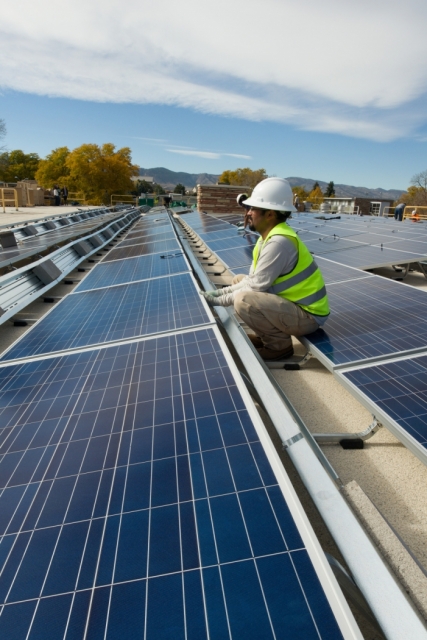
“Universities all over the country are watching us right now, and they’re thinking, ‘If that works for them, maybe we’ll dip our toes in that water too,’” says Kate Bartter, director of Ohio State’s office of energy and environment.
Other campuses have initiated their own experiments. In 2015, Yale University launched a pilot project to experiment with different ways of imposing an internal carbon charge and reducing greenhouse gas emissions. The initiative divides 20 campus buildings into four groups to test a spectrum of carbon-pricing schemes.
One model has buildings compete for budgetary rebates; another gives them rebates when they hit certain carbon reduction targets; a third has buildings pay monthly carbon charges and apply a portion of year-end rebates to energy-saving projects; and the final model simply provides buildings with detailed information about their energy consumption. The experiment is designed not only to cut campus energy use, but also to help other institutions gauge which policies are most effective in slashing emissions.
Transportation is a stumbling block
As Bartter of Ohio State readily admits, one of her university’s greatest carbon challenges has nothing to do with on-campus infrastructure — instead, it’s alleviating the climate impacts of transportation. At many institutions, commuting to campus represents a significant source of emissions. Students and faculty also rack up countless miles attending trips and conferences, leading one group of academics to launch a petition calling on academia to reduce its collective flying.
Although Arizona State’s campus intends to become carbon-neutral by 2025, it will take the university another decade to compensate for transportation. “You can’t force your employees to live next to campus and not drive,” Darosa points out.
Progress at smaller schools
Hampshire College is completing a 19-acre solar array, as it seeks to produce all its power from renewables. Managing growth, offsetting transportation emissions, and renovating buildings is often easier for private schools, which contend with less red tape and have smaller carbon footprints. Later this year, Hampshire College, in Massachusetts, will complete construction on a 19-acre solar array, the focal point of the college’s plan to generate all of its electricity from on-site renewables. Colby College in Maine, Green Mountain College and Middlebury in Vermont, and Oberlin College — none of which have a student population larger than 3,000 — all perch within the Sierra Club’s top 20.
Atop the rankings sits College of the Atlantic, a tiny liberal arts college in Maine whose student body counts just 350 undergraduates — fewer than some public schools cram into a single Biology 101 lecture hall. In 2007, College of the Atlantic became the country’s first carbon-neutral school, an objective it achieved primarily by investing in offsets provided by a traffic light optimization project in Portland, Oregon.
Although the offsets cost just $22,000, the purchase wasn’t universally popular — some students argued that the college should concentrate on improving on-campus efficiency and fostering Maine’s renewable energy industry.
Today, College of the Atlantic no longer buys offsets, but it gets more than 40% of its energy from wind farms, community solar projects, local wood pellets, and other fossil-fuel-free sources. The college now plans to go carbon-free by 2050 — a target that Anna Demeo, director of energy education and management, says it’s on track to beat.
“We had to lose the title of carbon neutrality,” Demeo says. “But in the end that title wasn’t as important as teaching students from the ground-up how to participate in local renewable energy economies.”
State edicts also can help
In some cases, being a public institution can be a blessing in disguise. State regulations and policies designed to cut costs or achieve climate goals may force public campuses to clean up their acts. In Massachusetts, a 2007 executive order directing state buildings to reduce their environmental impact led the University of Massachusetts system to slash its greenhouse gas emissions by 17%.
Those gains aren’t unique to the Bay State: Between 2007 and 2014, private institutions reduced their energy consumption by just 2%, while public universities sliced consumption by 5%.
The imperative to save money is also a powerful motivator. At Colorado State, the volatility of natural gas prices convinced administrators to embrace comparatively stable solar power. At Ohio State, the declining cost of wind power has guided renewable purchases. “We locked in a long-term price for 20 years,” says Bartter, of Ohio State. “While wind is a bit more expensive right now, I bet it’ll be cheaper in 10 years than the rest of the power we’re buying.”
Universities have also sought to integrate new academic research into facilities operations. At Portland State University in Oregon, a recently launched Living Lab initiative connects student research projects with campus sustainability programs, such as waste reduction efforts. Ohio State’s researchers use wind turbines to study rotor design, and College of the Atlantic students install community solar panels. And in Tempe, Darosa hopes to deploy carbon-capture processes being developed by Arizona State faculty to further slash the university’s footprint.
“We want to be an exemplar for our students, for the community, and for other institutions,” Darosa says. “What could be a better use for a university than to develop cutting-edge technology and apply it in a practical way on campus?”
Ben Goldfarb is a freelance environmental journalist based in New Haven, Conn. This post originally appeared at Yale Environment 360.
Weekly Newsletter
Get building science and energy efficiency advice, plus special offers, in your inbox.




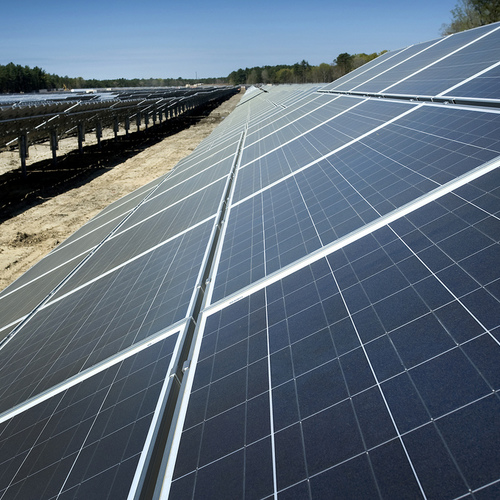

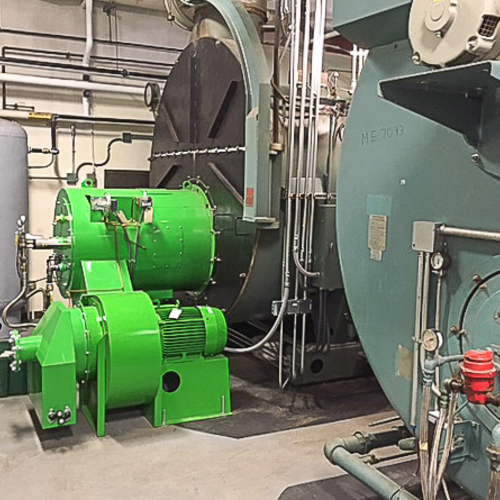
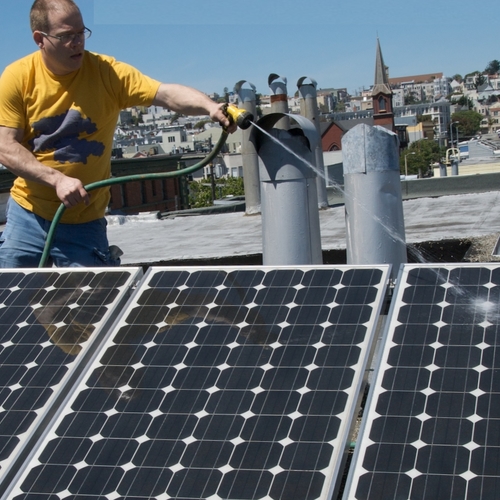






0 Comments
Log in or create an account to post a comment.
Sign up Log in